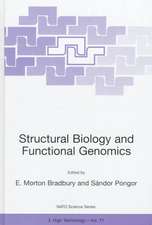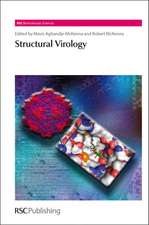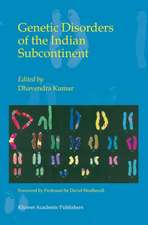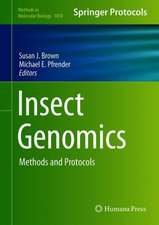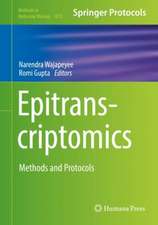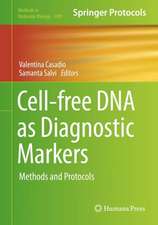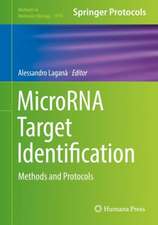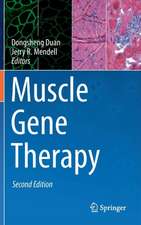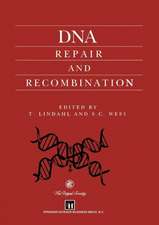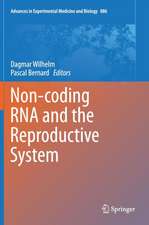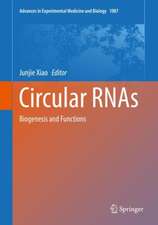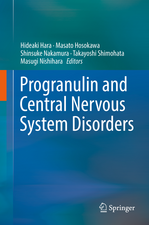Carbonic Anhydrase: Mechanism, Regulation, Links to Disease, and Industrial Applications: Subcellular Biochemistry, cartea 75
Editat de Susan C. Frost, Robert McKennaen Limba Engleză Hardback – 5 noi 2013
| Toate formatele și edițiile | Preț | Express |
|---|---|---|
| Paperback (1) | 1102.10 lei 6-8 săpt. | |
| SPRINGER NETHERLANDS – 23 aug 2016 | 1102.10 lei 6-8 săpt. | |
| Hardback (1) | 1109.44 lei 6-8 săpt. | |
| SPRINGER NETHERLANDS – 5 noi 2013 | 1109.44 lei 6-8 săpt. |
Din seria Subcellular Biochemistry
- 18%
 Preț: 948.79 lei
Preț: 948.79 lei - 5%
 Preț: 1456.88 lei
Preț: 1456.88 lei - 18%
 Preț: 1373.84 lei
Preț: 1373.84 lei - 18%
 Preț: 1243.78 lei
Preț: 1243.78 lei - 18%
 Preț: 2098.81 lei
Preț: 2098.81 lei - 18%
 Preț: 1122.10 lei
Preț: 1122.10 lei - 5%
 Preț: 1160.63 lei
Preț: 1160.63 lei - 18%
 Preț: 1396.26 lei
Preț: 1396.26 lei - 18%
 Preț: 1114.96 lei
Preț: 1114.96 lei - 18%
 Preț: 1224.68 lei
Preț: 1224.68 lei - 18%
 Preț: 951.29 lei
Preț: 951.29 lei - 18%
 Preț: 1227.99 lei
Preț: 1227.99 lei -
 Preț: 398.15 lei
Preț: 398.15 lei -
 Preț: 399.88 lei
Preț: 399.88 lei - 18%
 Preț: 1231.47 lei
Preț: 1231.47 lei - 18%
 Preț: 1230.35 lei
Preț: 1230.35 lei -
 Preț: 392.60 lei
Preț: 392.60 lei - 18%
 Preț: 1231.47 lei
Preț: 1231.47 lei - 15%
 Preț: 638.76 lei
Preț: 638.76 lei - 5%
 Preț: 656.26 lei
Preț: 656.26 lei -
 Preț: 389.49 lei
Preț: 389.49 lei - 5%
 Preț: 659.19 lei
Preț: 659.19 lei -
 Preț: 392.37 lei
Preț: 392.37 lei - 5%
 Preț: 662.09 lei
Preț: 662.09 lei -
 Preț: 395.09 lei
Preț: 395.09 lei - 5%
 Preț: 667.99 lei
Preț: 667.99 lei -
 Preț: 400.47 lei
Preț: 400.47 lei - 18%
 Preț: 1224.54 lei
Preț: 1224.54 lei - 15%
 Preț: 647.73 lei
Preț: 647.73 lei - 15%
 Preț: 646.75 lei
Preț: 646.75 lei - 5%
 Preț: 662.30 lei
Preț: 662.30 lei -
 Preț: 395.25 lei
Preț: 395.25 lei - 18%
 Preț: 1230.21 lei
Preț: 1230.21 lei - 18%
 Preț: 1231.95 lei
Preț: 1231.95 lei - 18%
 Preț: 964.54 lei
Preț: 964.54 lei
Preț: 1109.44 lei
Preț vechi: 1167.83 lei
-5% Nou
Puncte Express: 1664
Preț estimativ în valută:
212.32€ • 230.54$ • 178.35£
212.32€ • 230.54$ • 178.35£
Carte tipărită la comandă
Livrare economică 22 aprilie-06 mai
Preluare comenzi: 021 569.72.76
Specificații
ISBN-13: 9789400773585
ISBN-10: 9400773587
Pagini: 440
Ilustrații: IX, 430 p. 75 illus., 37 illus. in color.
Dimensiuni: 155 x 235 x 29 mm
Greutate: 0.79 kg
Ediția:2014
Editura: SPRINGER NETHERLANDS
Colecția Springer
Seria Subcellular Biochemistry
Locul publicării:Dordrecht, Netherlands
ISBN-10: 9400773587
Pagini: 440
Ilustrații: IX, 430 p. 75 illus., 37 illus. in color.
Dimensiuni: 155 x 235 x 29 mm
Greutate: 0.79 kg
Ediția:2014
Editura: SPRINGER NETHERLANDS
Colecția Springer
Seria Subcellular Biochemistry
Locul publicării:Dordrecht, Netherlands
Public țintă
ResearchCuprins
Preface. Part I Introduction.- Overview of the Carbonic Anhydrase Field.- Part II Carbonic Anhydrases: Ancient but Relevant. Physiological Functions of the Alpha Class of Carbonic Anhydrases.- Catalytic Mechanism of α-Class Carbonic Anhydrases: CO2 Hydration and Proton Transfer.- Structure and Catalytic Mechanism of b-Carbonic Anhydrases.- Prokaryotic Carbonic Anhydrases of Earth’s Environment.- Carboxysomal Carbonic Anhydrases.- Carbonic Anhydrases and their Interplay with Acid/base-coupled Membrane Transporters.- Carbonic Anhydrase Related Proteins: Molecular Biology and Evolution.- Membrane Associated Carbonic Anhydrase IV (CA IV): A Personal and Historical Perspective.- Carbonic Anhydrase Expression in Kidney and Renal Cancer: Implications for Diagnosis and Treatment.- Carbonic Anhydrase IX: Regulation and Role in Cancer.- Carbonic Anhydrase IX as an Imaging and Therapeutic Target for Tumors and Metastases.- Carbonic Anhydrase IX (CAIX) as a Mediator of Hypoxia-induced Stress Response in Cancer Cells.- Carbonic Anhydrases and Brain pH in the Control of Neruronal Excitability.- Carbonic Anhydrase Inhibitors: Drug Design.- Natural Products that Inhibit Carbonic Anhydrases.- Glaucoma and the Application of Carbonic Anhydrase Inhibitors.- Carbonic Anhydrase Inhibitors and High Altitude Illnesses.- Thermal-Stable Carbonic Anhydrases: A Structural Overview.- Carbonic Anhydrases in Industrial Applications. Index.
Textul de pe ultima copertă
The study of carbonic anhydrase has spanned multiple generations of scientists. Carbonic anhydrase was first discovered in 1932 by Meldrum and Roughton. Inhibition by sulfanilamide was shown in 1940 by Mann and Keilin. Even Hans Krebs contributed to early studies with a paper in 1948 showing the relationship of 25 different sulfonamides to CA inhibition. It was he who pointed out the importance of both the charged and uncharged character of these compounds for physiological experiments.
The field of study that focuses on carbonic anhydrase (CA) has exploded in recent years with the identification of new families and isoforms. The CAs are metalloenzymes which are comprised of 5 structurally different families: the alpha, beta, gamma, and delta, and epsilon classes. The alpha class is found primarily in animals with several isoforms associated with human disease. The beta CAs are expressed primarily in plants and are the most divergent. The gamma CAs are the most ancient. These are structurally related to the beta CAs, but have a mechanism more similar to the alpha CAs. The delta CAs are found in marine algae and diflagellates. The epsilon class is found in prokaryotes in which it is part of the carboxysome shell perhaps supplying RuBisCO with CO2 for carbon fixation.
With the excitement surrounding the discovery of disease-related CAs, scientists have redoubled their efforts to better understand structure-function relationships, to design high affinity, isotype-specific inhibitors, and to delineate signaling systems that play regulatory roles over expression and activity. We have designed the book to cover basic information of mechanism, structure, and function of the CA families. The authors included in this book bring to light the newest data with regard to the role of CA in physiology and pathology, across phylums, and inunique environmental niches.
Caracteristici
Up to date reference for researchers and students in the carbonic anhydrase family Contributions from internationally recognized investigators at the forefront of the carbonic anhydrase field Mix of topics to reach audiences with interests across phylums




